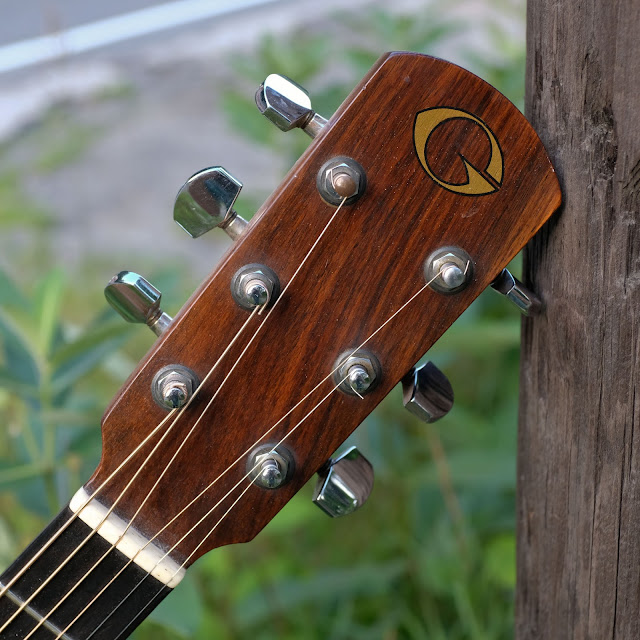1980 Gurian JM Mini-Jumbo Flattop Guitar
Gurians are nice guitars. They're built to high marks throughout, use quality materials, and tend to have that "boutique" tone in spades. I'm not sure I even know what I mean by that, but I use it to peg something that's creamy throughout its range, balanced, sweet-sounding, and yet with a good amount of volume at the same time. It's hard to get those contrasting desires in a single guitar and it's about a 90-degree turn from my own preferences for that early-to-mid-'50s Gibson dry-and-punchy sound. Regardless, if you have listeners sit in a room and judge guitars played on their own, Gurians have the sort of sound the vast majority of those ears will voice fondness for with eyes closed.
All that aside, this is a customer's guitar that was in for repair. It needed a neck reset, a fret level/dress, a new saddle, and a setup. The reset was straightforward as one just needs to separate the fretboard extension and yank some wooden pins at the neckblock to get the non-glued, Gurian-style tenon joint loose. Because I don't care for that design (every Gurian joint I've come across is messed-up), I converted the joint to a bolt-on setup.
After the other work, it's turned into a solid player and is playing on-spec, though a truss rod that's ineffectual after a certain point of adjustment means that it's wearing 50w-11 strings to keep the neck straight rather than the 54w-12 it might have otherwise. It doesn't seem hurt by the step-down in tension, however.
Specs are: 25 1/2" scale, 1 5/8" nut width, 1 3/8" string spacing at the nut, 2 1/4" spacing at the bridge (lots of taper -- I like!), 15 3/8" lower bout, 11 3/4" upper bout, and 4 5/8" depth at the endblock. While the body size makes this a "000" guitar, its rounded shoulders and wider waist give it more of a mini-jumbo feel and shape. Action height is 3/32" EA and 1/16" DGBE at the 12th fret. The neck has a slim, C-shaped back profile and a board with almost no radius at all. It must be something like 16" or so.
Woods are: solid spruce top, solid mahogany back/sides, mahogany neck, and ebony fretboard. The bridge, binding, and headstock veneer are rosewood.
I had to be fairly aggressive with my level/dress job on the frets as years of neglect meant there was a lightly-bunched-up section of the fretboard near the neck joint from compression fatigue.
Luckily enough, a spare saddle I had in my bone bits-box was almost the perfect cut for the slot.
Pretty hog, right? It's got some good, mixed, silvery-looking grain running through it all over.


















Comments